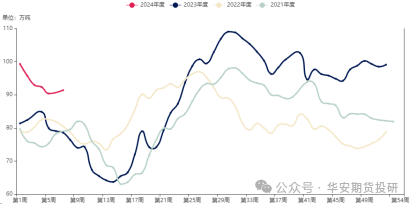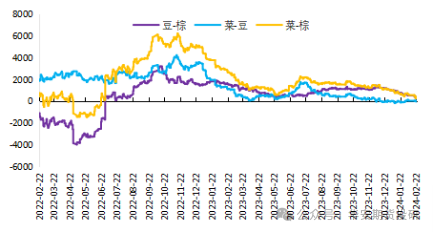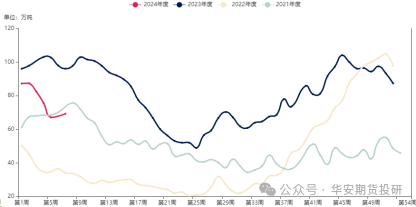Hua'an Futures
Although many heavy reports and policy news disturbed the external market during the Spring Festival, these twists and turns had limited impact on the edible oil market after the festival, and soybean brown rapeseed oil showed a fluctuating trend after a slight rebound. Such performance also fully reflects that the oil and fat fundamentals have not changed significantly compared with those before the Spring Festival, and loose supply and weak demand are still the main theme.
The supply pressure of soybean oil remains unchanged
CBOT soybean The main contract 05 has been falling smoothly since the middle of November last year, and has dropped 20% from the high point of 1419.74 cents/bushel.
Patria Agronegocios, a consultancy, said last Friday that the soybean harvest of Brazilian farmers in 2023/24 was 38.03%, up from 34.51% in the same period last year. While Brazil has successfully harvested soybeans, the lack of precipitation in some Argentine production areas still cannot shake the strong expectation of high yield: the Buenos Aires Grain Exchange said in a report that as of the week of February 21, the excellent growth rate of soybean crops in Argentina in 2023/24 was 31%, unchanged from the previous week, and far more than 2% in the same period last year.
In the pattern of global soybean supply turning to loose, the cost of import end fell with CBOT soybeans, but the arrival of domestic imported soybeans in the first quarter was low. According to the statistics of the Steel Federation, China imported about 5.5 million tons of soybeans in March (685.3 tons last year). Even so, China's port stocks of imported soybeans are still at a high level in the same period. After the centralized shutdown during the Spring Festival, the operating rate of oil plants gradually recovered after the festival, which will effectively increase the supply of soybean oil. As of February 16, the commercial stock of soybean oil in key areas of the country had reached 914000 tons, an increase of 10500 tons or 1.13% from the previous month.
Statistics of soybean oil inventory of national key oil plants (10000 tons)
 (Data source: Steel Union data)
(Data source: Steel Union data) After the centralized replenishment after the festival, the base difference of soybean oil in various regions has weakened. Taking East China as an example, the base difference in the first week after the festival has dropped from 660-700 yuan/ton to 600-650 yuan/ton. The next two months are in the traditional low consumption season of oil and fat. It is expected that soybean oil will still be mainly accumulated, with weak price support.
Uncertainty of vegetable oil
Last year, China purchased a large amount of imported rapeseed, which was the main reason for the decline of rapeseed oil for seven months (possibly longer). Recently, due to the improvement of profit extraction, oil plants also bought new ships to suppress the price of rapeseed oil. According to the statistics of Steel Union, as of February 16, the rapeseed inventory of major oil plants in coastal areas was 444000 tons, an increase of 116500 tons compared with that before the festival. The huge pressure on rapeseed continues to undermine the price of rapeseed oil.
However, there are two points worth noting in the current vegetable oil market:
First, due to the low price difference between bean vegetable and vegetable palm, even the upside down situation, rapeseed oil is more cost-effective than competitive fats. Although the pressure on imported rapeseed inventory is huge, the vegetable oil depot has continued to decline for nearly three months, reflecting that downstream picking up is OK, and there will be resistance in the future, but the low price difference also makes the demand for rapeseed oil worth looking forward to.
Spot price difference of four beans, four dishes and 24 degree brown oil in East China (yuan/ton)
 (Data source: Flush)
(Data source: Flush) Second, the impact of this cold wave cannot be ignored. The yield of the two lakes region accounts for more than one-third. The local rape is in the bolting period. The freezing rain and snowfall will cause damage to the rape and susceptible to infection with bacteria. Whether there will be substantial yield reduction needs to be combined with the flowering period.
The fact that the fundamentals of rapeseed oil are weak is hard to change, but the removal of rapeseed oil from storage and the potential yield reduction risk of domestic rapeseed can also provide some support for rapeseed oil.
Palm Oil is the mainstay
At present, palm oil is still in the production reduction cycle. According to the seasonal law, with the temperature rising, palm oil in Southeast Asia will enter the production increase cycle in March. However, since the first ten days of March this year's Ramadan, the number of workers in Malaysia and Indonesia will be significantly reduced during the general Ramadan, leading to a decline in palm oil production. Therefore, the production reduction of palm oil may continue to April.
The official monthly report data of Malaysia showed that the inventory of Malaysian palm oil at the end of January was 2019800 tons. Although it was at a relatively high level in the same period of history, the approximate rate of inventory continued to decline in the context of production reduction. The recent devaluation of the Malaysian ringgit was conducive to the export of Malaysian palm oil, making the fundamentals of palm oil significantly better than soybean oil, We see that the recent trend of horse palm oil is significantly stronger than that of CBOT soybean oil and ICE rapeseed.
As the consumption of palm oil in China is mainly 24 ℃, the consumption of palm oil is relatively light in the winter when the temperature drops in a large area of China. However, due to the poor import profit, the number of domestic ships purchased in recent months was relatively small, and the overall palm oil storage in domestic ports showed a downward trend.
Seasonal inventory of palm oil (10000 tons)
 (Data source: Steel Union data)
(Data source: Steel Union data) However, at present, whether domestic or international, the oil price difference between soybean and palm oil is upside down, which weakens the competitive advantage of palm oil and limits the upper price space to a certain extent.
Hua'an Futures Investment Consulting Business Qualification CSRC License [2011] 1776
He Meng, senior analyst
Employment/investment consultation certificate No.: F3033829/Z0014543
Reviewed by: Xia Yuchen F3031745/Z0014542
Safe, fast and guaranteed futures account opening on Sina cooperation platform

Massive information, accurate interpretation, all in Sina Finance APP
Editor in charge: Dai Ming SF006











